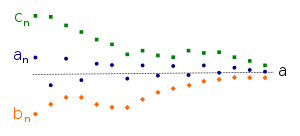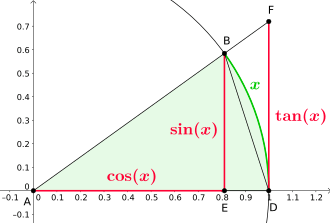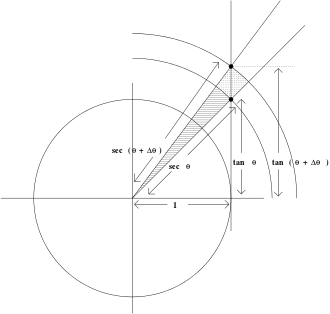Squeeze theorem
In calculus, the squeeze theorem, also known as the pinching theorem, the sandwich theorem, the sandwich rule, and sometimes the squeeze lemma, is a theorem regarding the limit of a function. In Italy, the theorem is also known as theorem of carabinieri.
sin(x%5E(-1)).png)

The squeeze theorem is used in calculus and mathematical analysis. It is typically used to confirm the limit of a function via comparison with two other functions whose limits are known or easily computed. It was first used geometrically by the mathematicians Archimedes and Eudoxus in an effort to compute π, and was formulated in modern terms by Carl Friedrich Gauss.
In many languages (e.g. French, German, Italian, Hungarian and Russian), the squeeze theorem is also known as the two policemen (and a drunk) theorem, or some variation thereof. The story is that if two policemen are escorting a drunk prisoner between them, and both officers go to a cell, then (regardless of the path taken, and the fact that the prisoner may be wobbling about between the policemen) the prisoner must also end up in the cell.
Statement
The squeeze theorem is formally stated as follows.[1]
Let I be an interval having the point a as a limit point. Let g, f, and h be functions defined on I, except possibly at a itself. Suppose that for every x in I not equal to a, we have
and also suppose that
Then
- The functions and are said to be lower and upper bounds (respectively) of .
- Here, is not required to lie in the interior of . Indeed, if is an endpoint of , then the above limits are left- or right-hand limits.
- A similar statement holds for infinite intervals: for example, if , then the conclusion holds, taking the limits as .
This theorem is also valid for sequences. Let be two sequences converging to , and a sequence. If we have , then also converges to .
Proof
According to the above hypotheses we have, taking the limit inferior and superior:
so all the inequalities are indeed equalities, and the thesis immediately follows.
A direct proof, using the -definition of limit, would be to prove that for all real there exists a real such that for all with , we have . Symbolically,
As
means that
and
means that
then we have
We can choose . Then, if , combining (1) and (2), we have
- ,
which completes the proof.
The proof for sequences is very similar, using the -definition of a limit of a sequence.
Statement for series
There is also the squeeze theorem for series, which can be stated as follows:
Let be two convergent series. If such that then also converges.
Proof
Let be two convergent series. Hence, the sequences are Cauchy. That is, for fixed ,
such that (1)
and similarly such that (2).
We know that such that . Hence, , we have combining (1) and (2):
.
Therefore is a Cauchy sequence. So converges.
Examples
First example

The limit
cannot be determined through the limit law
because
does not exist.
However, by the definition of the sine function,
It follows that
Since , by the squeeze theorem, must also be 0.
Second example

Probably the best-known examples of finding a limit by squeezing are the proofs of the equalities
The first limit follows by means of the squeeze theorem from the fact that
for x close enough to 0. The correctness of which for positive x can be seen by simple geometric reasoning (see drawing) that can be extended to negative x as well. The second limit follows from the squeeze theorem and the fact that
for x close enough to 0. This can be derived by replacing in the earlier fact by and squaring the resulting inequality.
These two limits are used in proofs of the fact that the derivative of the sine function is the cosine function. That fact is relied on in other proofs of derivatives of trigonometric functions.
Third example
It is possible to show that
by squeezing, as follows.

In the illustration at right, the area of the smaller of the two shaded sectors of the circle is
since the radius is sec θ and the arc on the unit circle has length Δθ. Similarly, the area of the larger of the two shaded sectors is
What is squeezed between them is the triangle whose base is the vertical segment whose endpoints are the two dots. The length of the base of the triangle is tan(θ + Δθ) − tan(θ), and the height is 1. The area of the triangle is therefore
From the inequalities
we deduce that
provided Δθ > 0, and the inequalities are reversed if Δθ < 0. Since the first and third expressions approach sec2θ as Δθ → 0, and the middle expression approaches (d/dθ) tan θ, the desired result follows.
Fourth example
The squeeze theorem can still be used in multivariable calculus but the lower (and upper functions) must be below (and above) the target function not just along a path but around the entire neighborhood of the point of interest and it only works if the function really does have a limit there. It can, therefore, be used to prove that a function has a limit at a point, but it can never be used to prove that a function does not have a limit at a point.[3]
cannot be found by taking any number of limits along paths that pass through the point, but since
therefore, by the squeeze theorem,
References
- Sohrab, Houshang H. (2003). Basic Real Analysis (2nd ed.). Birkhäuser. p. 104. ISBN 978-1-4939-1840-9.
- Selim G. Krejn, V.N. Uschakowa: Vorstufe zur höheren Mathematik. Springer, 2013, ISBN 9783322986283, pp. 80-81 (German). See also Sal Khan: Proof: limit of (sin x)/x at x=0 (video, Khan Academy)
- Stewart, James (2008). "Chapter 15.2 Limits and Continuity". Multivariable Calculus (6th ed.). pp. 909–910. ISBN 0495011630.
External links
- Weisstein, Eric W. "Squeezing Theorem". MathWorld.
- Squeeze Theorem by Bruce Atwood (Beloit College) after work by, Selwyn Hollis (Armstrong Atlantic State University), the Wolfram Demonstrations Project.
- Squeeze Theorem on ProofWiki.